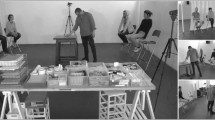Abstract
This study describes four experiments which support the hypothesis that Posture-Gesture Mergers (PGMs) accompany verbal expressions that are truthful, relaxed, sincere, or authentic. PGMs are defined as body movements which occur when a posture (full body movement) leads into a gesture (partial body movement) or vice versa. Proportion of PGMs to nonPGMs constituted the dependent variable. Three experiments manipulated situational conditions in order to affect PGMs. In the first study, PGM behavior was compared when subjects were instructed to lie vs. when they were instructed to tell the truth. In the second study, PGM behavior was compared when subjects were frustrated vs. not frustrated by an experimental task. In the third study, PGM behavior was studied after subjects underwent relaxation training. The fourth study assessed naturally occuring PGM rates in a debate tournament and showed that PGMs are positively correlated with a judge's ratings of contestants' relaxation, sincerity, and effectiveness. Implications of the research for Action Profiling, as well as dance, movement, and body therapy, are addressed.
Similar content being viewed by others
References
Alexander, F.M. (1932).The use of the self: Its conscious direction in relation to diagnosis, functioning, and the control of reaction. New York: E.P. Dutton & Company.
Alexander, F.M. (1941).The universal constant in living. New York: E.P. Dutton & Company.
Allport, G.W. (1937).Personality: A psychological interpretation. New York: Holt.
Allport, G.W. (1950).The individual and his religion. New York: Macmillan.
Allport, G.W. & Vernon, P.E. (1933).Studies in expressive movement. New York: Macmillan.
Aronson, E. (1987).The social animal (5th ed.). New York: W.H. Freeman.
Bartenieff, I. (1980).Body movement: Coping with the environment. New York: Gordon and Breach Science Publishers.
Condon, W.S. (1969). Linguistic-kinesic research and dance therapy. InAmerican Dance Therapy Association Combined Proceedings, 1968/1969. Baltimore, MD: American Dance Therapy Association.
Condon, W.S. (1982). Cultural microrhythms. In Davis, M. (Ed.)Interaction rhythms: Periodicity in communicative behavior. New York: Human Science Press, Inc.
Condon, W.S. & Ogston, W.D. (1966). Sound film analysis of normal and pathological behavior patterns.Journal of Nervous and Mental Disease, 143 338–347.
Davis, M. (1987). Steps to achieving observor agreement: The LIMS reliability project.Movement Studies, 2 7–20.
Ekman, P. and Friesen, W.V. (1969). The repertoire of nonverbal behavioral categories—origins, usage, and coding.Semiotica, 1 49–98.
Feldenkrais, M. (1977).Awareness through movement: Health exercises for personal growth. New York: Harper & Row.
Festinger, L. (1957).A theory of cognitive dissonance. Stanford, CA: Stanford University Press.
Freud, S. (1939).An outline of psychoanalysis. New York: Norton.
Haner, C.F., & Brown, P.A. (1955). Clarification of the instigation to action concept in the frustration-aggression hypothesis.Journal of Abnormal and Social Psychology, 59 17–22.
Jacobson, E. (1974).Progressive relaxation. Chicago: University of Chicago Press (Midway Reprint).
James, W. (1902).The varieties of religious experience. New York: Longman.
Juhan, D. (1987).Job's body: A handbook for bodywork. Barrytown, NY: Station Hill Press.
Laban, R. (1956).Principles of dance and movement notation. London: Macdonald & Evans.
Laban, R. (1960).The mastery of movement. London: Macdonald & Evans.
Laban, R. (1963).Modern educational dance. London: Macdonald & Evans.
Laban, R. (1966).Choreutics. London: Macdonald & Evans.
Laban, R. & Lawrence, F.C. (1947).Effort. London: Macdonald & Evans.
Lamb, W. (1965).Posture and gesture: An introduction to the study of physical behaviour. London: Gerald Duckworth.
Lamb, W. & Watson, E. (1979).Body code: The meaning in movement. London: Routledge & Kegan Paul.
Lowen, A. (1971).The language of the body. Indialantic, FL: Collier.
Lowen, A. (1977).Bioenergetics. New York: Penguin.
Moore, C. (1982).Executives in action: A guide to balanced decision-making in management (2nd ed.). Plymouth, England: Macdonald & Evans.
Moore, C., & Yamamoto, K. (1988).Beyond words: Movement observation and analysis. New York: Gordon and Breach.
Perls, F.S. (1969).Gestalt therapy verbatim. Lafayette, CA: Real People Press.
Ramsden, P. (1973).Top team planning: A study of the power of individual motivation in management. London: Associated Business Programmes.
Rolf, I.P. (1963). Structural integration: Gravity, an unexplored factor in a more human use of human beings.Systematics, 1 66–83.
Rosenthal, R. (1983). Conducting judgement studies. In P. Ekman and K. Scherer (Eds.)Handbook of nonverbal behavior research methods. Cambridge: Cambridge University Press.
Winter, D.D. (1987). Field studies of Action Profiling reliability.Movement Studies, 2 21–22.
Author information
Authors and Affiliations
Additional information
This work was supervised and written by the senior author. Each of the junior authors designed one experiment and collected data, as well as served as a judge for a second experiment.
Rights and permissions
About this article
Cite this article
Du Nann Winter, D., Widell, C., Truitt, G. et al. Empirical studies of Posture-Gesture Mergers. J Nonverbal Behav 13, 207–223 (1989). https://doi.org/10.1007/BF00990294
Issue Date:
DOI: https://doi.org/10.1007/BF00990294




